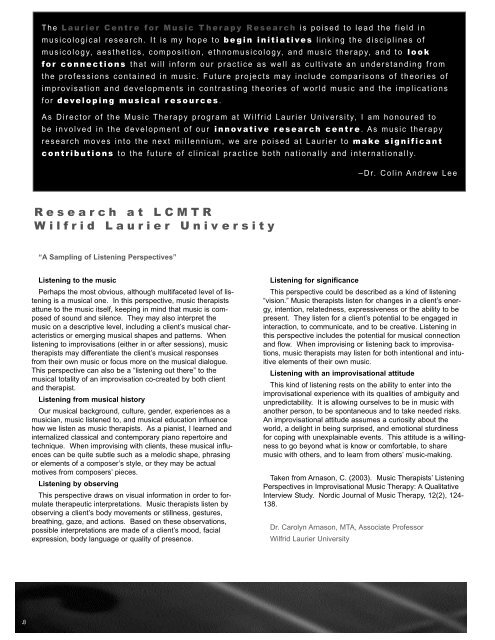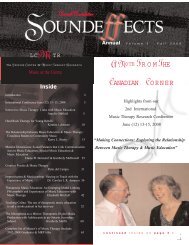The Laurier Centre <strong>for</strong> <strong>Music</strong> <strong>Therapy</strong> Research is poised to lead the field inmusicological research. It is my hope to begin initiatives linking the disciplines ofmusicology, aesthetics, composition, ethnomusicology, <strong>and</strong> music therapy, <strong>and</strong> to look<strong>for</strong> connections that will in<strong>for</strong>m our practice as well as cultivate an underst<strong>and</strong>ing fromthe professions contained in music. Future projects may include comparisons of theories ofimprovisation <strong>and</strong> developments in contrasting theories of world music <strong>and</strong> the implications<strong>for</strong> developing musical resources.As Director of the <strong>Music</strong> <strong>Therapy</strong> program at Wilfrid Laurier University, I am honoured tobe involved in the development of our innovative research centre. As music therapyresearch moves into the next millennium, we are poised at Laurier to make significantcontributions to the future of clinical practice both nationally <strong>and</strong> internationally.–Dr. Colin Andrew LeeResearch at LCMTRWilfrid Laurier University“A Sampling of Listening Perspectives”Listening to the musicPerhaps the most obvious, although multifaceted level of listeningis a musical one. In this perspective, music therapistsattune to the music itself, keeping in mind that music is composedof sound <strong>and</strong> silence. They may also interpret themusic on a descriptive level, including a client’s musical characteristicsor emerging musical shapes <strong>and</strong> patterns. Whenlistening to improvisations (either in or after sessions), musictherapists may differentiate the client’s musical responsesfrom their own music or focus more on the musical dialogue.This perspective can also be a “listening out there” to themusical totality of an improvisation co-created by both client<strong>and</strong> therapist.Listening from musical historyOur musical background, culture, gender, experiences as amusician, music listened to, <strong>and</strong> musical education influencehow we listen as music therapists. As a pianist, I learned <strong>and</strong>internalized classical <strong>and</strong> contemporary piano repertoire <strong>and</strong>technique. When improvising with clients, these musical influencescan be quite subtle such as a melodic shape, phrasingor elements of a composer’s style, or they may be actualmotives from composers’ pieces.Listening by observingThis perspective draws on visual in<strong>for</strong>mation in order to <strong>for</strong>mulatetherapeutic interpretations. <strong>Music</strong> therapists listen byobserving a client’s body movements or stillness, gestures,breathing, gaze, <strong>and</strong> actions. Based on these observations,possible interpretations are made of a client’s mood, facialexpression, body language or quality of presence.Listening <strong>for</strong> significanceThis perspective could be described as a kind of listening“vision.” <strong>Music</strong> therapists listen <strong>for</strong> changes in a client’s energy,intention, relatedness, expressiveness or the ability to bepresent. They listen <strong>for</strong> a client’s potential to be engaged ininteraction, to communicate, <strong>and</strong> to be creative. Listening inthis perspective includes the potential <strong>for</strong> musical connection<strong>and</strong> flow. When improvising or listening back to improvisations,music therapists may listen <strong>for</strong> both intentional <strong>and</strong> intuitiveelements of their own music.Listening with an improvisational attitudeThis kind of listening rests on the ability to enter into theimprovisational experience with its qualities of ambiguity <strong>and</strong>unpredictability. It is allowing ourselves to be in music withanother person, to be spontaneous <strong>and</strong> to take needed risks.An improvisational attitude assumes a curiosity about theworld, a delight in being surprised, <strong>and</strong> emotional sturdiness<strong>for</strong> coping with unexplainable events. This attitude is a willingnessto go beyond what is know or com<strong>for</strong>table, to sharemusic with others, <strong>and</strong> to learn from others’ music-making.Taken from Arnason, C. (2003). <strong>Music</strong> Therapists’ ListeningPerspectives in Improvisational <strong>Music</strong> <strong>Therapy</strong>: A QualitativeInterview Study. Nordic Journal of <strong>Music</strong> <strong>Therapy</strong>, 12(2), 124-138.Dr. Carolyn Arnason, MTA, Associate ProfessorWilfrid Laurier University.8
“Searching <strong>for</strong> milestones: The analysis of clinical improvisation<strong>for</strong> music therapy students <strong>and</strong> music therapists”Abstract: The research is intended to provide an opportunity<strong>for</strong> music therapists <strong>and</strong> music therapy students to be able toinspect where they are now, <strong>and</strong> also where they need to proceed,in order to possess <strong>and</strong> present an appropriately highlevel of proficiency in clinical improvisation. The research wasdesigned to analyze <strong>and</strong> compare the contents of clinicalimprovisation sessions collected from four interviewed participants<strong>for</strong> an educational purpose. The study investigated howmusic therapists <strong>and</strong> music therapy students perceive clinicalimprovisation, <strong>and</strong> sought to establish possible guidelines or criteria<strong>for</strong> successful clinical improvisation. The process of analysis<strong>and</strong> description was divided into two different levels: musicaldata analysis <strong>and</strong> verbal data analysis. The main focus of theresearch findings dealt with the critical analysis, not only from amusicological perspective, but also clinical perspective.Through the comparative analysis, the researcher found <strong>and</strong>discussed three significant points: 1) clinical improvisation as aclinical <strong>for</strong>m of communication 2) the use of vocalization in clinicalimprovisation as an effective <strong>and</strong> empathetic means of communication3) the correlation between clinical judgment <strong>and</strong>clinical listening <strong>and</strong> response. One of the unique qualities ofthe research content was to present solid in<strong>for</strong>mation in the<strong>for</strong>m of aurally transcribed musical analysis in addition to theverbal analysis from the interviews. The method of musicaldata analysis was adapted from that of Aesthetic <strong>Music</strong><strong>Therapy</strong> (AeMT) model (Lee, 2003)Sung-Yong Shim, MMTAbstract: This qualitative research study stemmed out of theresearcher’s quest to gain a deeper underst<strong>and</strong>ing of the therapeuticprocess in her music therapy practice. The analysis ofsessions with three individual clients using modified protocolanalysis <strong>and</strong> conceptions of grounded theory revealed five categoriesof themes present in the therapeutic interventions <strong>and</strong>relationships. Investigating the categories of expectation, invitation,challenge, being present, <strong>and</strong> validation led to a discoverythat the researcher-therapist’s value system, which was shapedby her life experiences, upbringing <strong>and</strong> culture, played a significantrole in the therapeutic process. Conducting this study hashelped the researcher to gain more awareness in both personal<strong>and</strong> professional aspects of her self, thereby contributing to thequality of her music therapy practice.Michelle Song, MMT“Burnout of operatic proportions: The impact of trauma on theexperience of burnout of Canadian <strong>Music</strong> Therapists”Abstract: The impact of unresolved personal trauma (Figley,1985) <strong>and</strong> unaddressed issues stemming from one’s family ororigin (Rompf & Royce, 1994) as well as workplace trauma(including trauma <strong>and</strong> vicarious traumatization) (Figley, 1985)impact on the experience of burnout in Canadian <strong>Music</strong>Therapists. In addition, workplace <strong>and</strong> professional factorssuch as a lack of supervision, debriefing <strong>and</strong> support, exacerbatethe experience of burnout as found in other helping professions(Cherniss, 1995). The dynamic <strong>and</strong> at times immediateprocess elicited in musical interventions (Lee, 2003) suggest adifferent therapeutic relationship from other helping professions.Therapist countertransference <strong>and</strong>/or vicarious traumatizationcan contribute to the experience of burnout, especially if thetherapist is lacking in study participant-identified skills such verbalinterventions <strong>and</strong> self-awareness (Rogers, 1992).Andrea Lamont, MMTAbstract: Introduction: Rap music <strong>and</strong> the aesthetics of HipHop culture represent a powerful, counter-cultural art <strong>for</strong>m thatis omni-present in the lives of members of contemporary youthculture. A weekly drop-in music therapy group was held <strong>for</strong> residentsof a youth shelter in Toronto. The most frequently usedclinical technique was clinical-improvisations in recognizablepopular music genres. Rap was the genre most frequentlyused. Mixed messages are imbedded in the culture of rapmusic as there are many examples of lyrics with anti-socialcontent <strong>and</strong> many examples of positive, potentially trans<strong>for</strong>mativelyrics. The positive <strong>and</strong> anti-social aspects of popular rapmusic were reflected in the sessions <strong>and</strong> resulted in clinicalchallenges <strong>and</strong> a rich body of recorded lyrics.Methods & Analysis: Clinical improvisations were recorded<strong>and</strong> lyrics transcribed verbatim. A qualitative, grounded theorymethod was used, to identify major themes. Major themeswere analyzed to determine what the potential, meaning of therap-therapy experience might be <strong>for</strong> the participants, <strong>and</strong> todetermine the therapeutic potential of this technique.Results: Major themes discovered in the lyrics closely paralleledverbal self-expression in psychotherapy. Participantsused the per<strong>for</strong>mance of rap to express emotions, spirituality,<strong>and</strong> vulnerability. The raps were also used to depicts threats<strong>and</strong> violence. Additionally strong connections were foundbetween the lyric analysis <strong>and</strong> a number of traditions in AfricanAmerican oral culture.Conclusions: The popularity, expressive power, <strong>and</strong> culturecontext of rap music combine to make it a potentially important<strong>and</strong> exciting resource <strong>for</strong> music therapists.Aaron Lightstone, MMTwww.wlu.ca99






